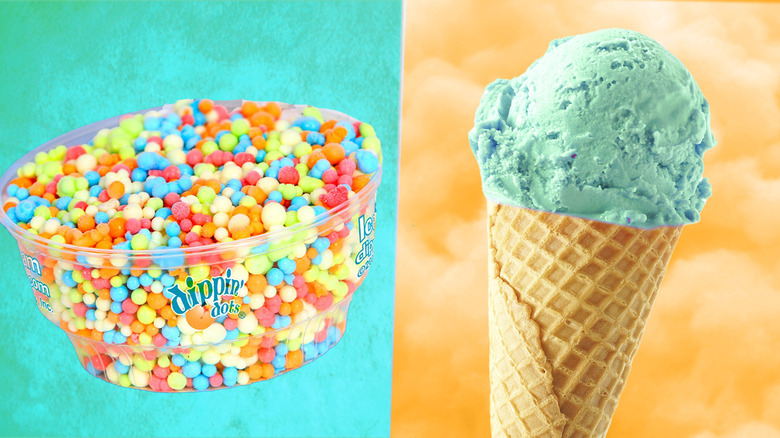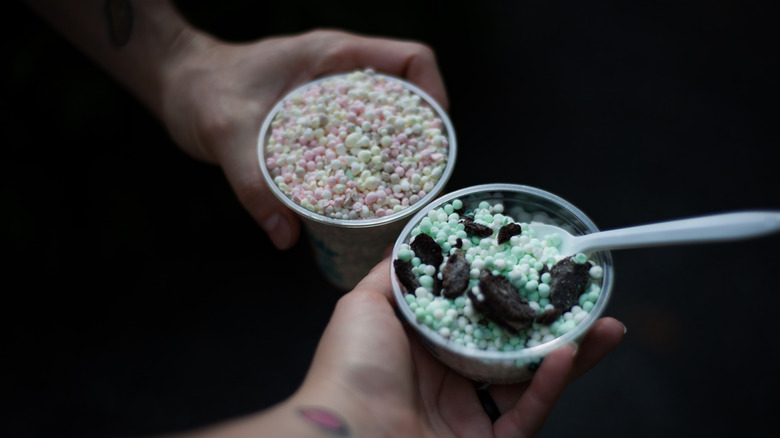Is Dippin' Dots Even Considered Real Ice Cream?
Dippin' Dots are the white whale of confections, often spoken of but rarely glimpsed for real. To get a taste of the sweet, colorful treasure requires going to an amusement park, movie theater, or one of the ever-dwindling number of malls left in America. You can't find Dippin' Dots in any grocery store because the freezers there aren't cold enough, nor is the one in your home. While the average home freezer keeps food chilled at 0 degrees Fahrenheit, Dippin' Dots start to melt if they go past -40 degrees. For this reason, they can only be sold from specialized facilities, but in a way, that adds to the appeal. The most exciting thing about Dippin' Dots is that they aren't like any other type of ice cream, which begs the question, are they really ice cream at all?
The short answer is that yes, Dippin' Dots technically count as ice cream. If they didn't, the brand wouldn't be able to use its famous, "Ice cream of the future," slogan. You see, the United States government places strict regulations on what products can be sold as "ice cream". If a product doesn't meet the cut, it has to use a different name, which is why Dairy Queen soft serve isn't called ice cream. However, those regulations are mainly focused on the ingredients that go into ice cream, and ingredients aren't what make Dippin' Dots unique. It's all about the production process.
How Dippin' Dots are made
Dippin' Dots are made with the use of cryogenic freezing. That's right, the same technology that preserved Ted Williams' head can also be used to make delicious ice cream. It's simpler than it sounds, and it all starts with the same basic ingredients as regular ice cream. In fact, the first stages of the Dippin' Dots production process simply entail making a standard ice cream base, and it's only in the freezing stage that things get unique. Dippin' Dots are frozen by pushing the ice cream base through narrow pipettes into a bath of -320-degree liquid nitrogen, where they freeze instantaneously. Each pipette is just 4 millimeters wide, forming the diameter of a standard Dippin' Dot.
If you've used an ice cream maker or tried making ice cream without a machine, you know that freezing ice cream can take a while. During that time, air pockets and ice crystals will form inside the ice cream. This doesn't happen with Dippin' Dots, though, because they freeze so quickly in the liquid nitrogen. The result is a denser and creamier texture than regular ice cream. The one caveat is that you pretty much have to eat Dippin' Dots the very second they come out of the freezer because as soon as they top -40 degrees, they start to soften into a single mass.
The rise and plateau of Dippin' Dots
It is fitting that an ice cream like no other should have an origin story like no other. With Dippin' Dots, their story starts with the last thing you'd expect: cow food. The iconic confection's inventor, Curt Jones, was a microbiologist experimenting with flash-freezing pellets of probiotics for cattle feed in the 1980s. One day, Jones was making a batch of homemade ice cream, and he started wondering how the frozen dessert would react to the cryogenic freezing process he'd developed at his job. He had long been bothered by the ice crystals that formed in ice cream, and he hoped that a faster freezing process would eliminate them. As it turned out, he was right.
In 1989, after a failed attempt at starting an ice cream parlor, Jones began selling Dippin' Dots through fairs and amusement parks, and the brand would see big growth in the 1990s. It hasn't been the same since, though, and that's mainly because other companies have picked up on Dippin' Dots technology. The most successful of these has been Mini Meltz, which uses more butterfat in its ice cream base than Dippin' Dots. Just like with custard versus soft serve, these subtle changes can make a big difference in texture. While it's unlikely that we'll ever see as much variety in cryogenic ice cream as we do with the regular stuff, Dippin' Dots isn't the only game in town anymore.


